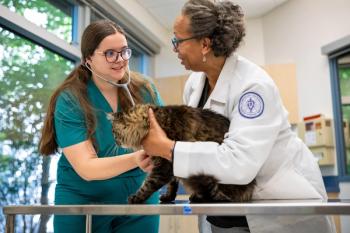
No outlet, no problemor is it?
Veterinary safety expert Phil Seibert offers dos and donts for electrical safety at your hospital.
One of the most common misconceptions when it comes to electrical safety, whether in a veterinary practice, home or public space, is that the biggest danger is electrocution, says Phil Seibert, CVPM, owner of SafetyVet in Calhoun Tennessee. In reality, a fire is much more likely to result from misused electrical components-power strips, specifically-than electrocution.
“We have a long history in the veterinary profession of making do with what we have, especially when it comes to our facilities,” Seibert told dvm360. “It's not common to completely overhaul the facility every 10 years like a human hospital. And now we have to plug everything in. A common thing people say is, ‘Oh there aren't enough outlets; I'll use this power strip.' The number-one thing that causes fires in veterinary practices is the misuse of power strips.”
Overloaded power strips can overheat, smoke and ignite. During the day a team member or veterinarian will most likely see or smell the problem and simply unplug the strip. But what happens when these problems arise at night? “We need to be proactive in our use of these items,” Seibert says. “With fire, in general you need to prevent it, not respond to it. Every minute you put into prevention saves hours in response.”
Seibert offers these dos and don'ts when it comes to the proper use of power strips in your veterinary practice:
Dos:
> Do use a power strip for electrical equipment only. They're not designed for high-wattage items.
> Do buy the best-quality power strip you can find. Some cheaper versions sold at discount stores aren't even surge protectors; they're multiplugs with an extension. Check the rating of the strip for the level of amps or wattage it can handle. The higher the rating, the more it can handle, and it's less likely to overheat.
> Do replace a power strip if it shows sign of damage, wear or melting.
> Do plug the strip straight into the wall. Never plug it into an extension cord or multiplug that's already plugged into the wall.
Don'ts:
> Don't bury the power strip under a pile of boxes or a curtain. Items covering the strip can overheat and catch fire.
> Don't use the strip as a substitute for an outlet. If you don't have enough structural outlets in your facility, call an electrician to wire more.
> Don't plug items such as space heaters, coffeepots or autoclaves into a power strip. They use too much wattage. Plug those items directly into a wall outlet.
Having a maintenance program in place is important as well, Seibert says. If something breaks, fix it. If an outlet or cord shows damage, have it inspected and repaired immediately. “I've gone into facilities and seen burn marks near the outlets in bathing or grooming areas,” he says. “This is caused by ‘arcing'-when a high-wattage item like a dryer cage is plugged in or unplugged without the power switch being turned off and the electrical current starts flowing between the plug and the outlet.” The fix? Always turn off the power before plugging in or unplugging.
Being able to access the circuit box quickly in the event of an electrical issue is also crucial. “As practices run out of storage space sometimes things get piled in front of the circuit breaker box, and that's dangerous,” Seibert says. “You need to be able to cut the power to the room or outlet that's causing problems right away. You waste time if you're moving boxes out of the way.”
Newsletter
From exam room tips to practice management insights, get trusted veterinary news delivered straight to your inbox—subscribe to dvm360.





